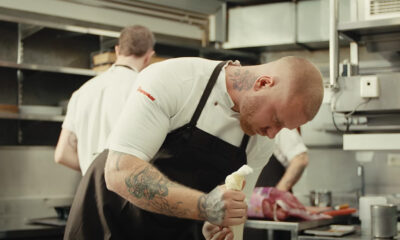Lifid
The truth about school dinners: what happened when Jamie went home
 It’s 16 months since the TV chef stormed through Britain’s school kitchens and declared war on the Turkey Twizzler. So are our children now eating healthier foods?
It’s 16 months since the TV chef stormed through Britain’s school kitchens and declared war on the Turkey Twizzler. So are our children now eating healthier foods?
Mark Cresswell remembers watching Jamie’s School Dinners back in March of last year. ‘I think I’d already concluded that the only way to get our school meals right was to do them ourselves,’ he says. ‘But watching Jamie Oliver convinced me of it.’ In 2003 Mark had been appointed to oversee the finances of a group of 15 primary schools in and around Chelmsford in Essex. That December, Essex Education Authority suddenly announced they were pulling out of school-meals provision. It was now the schools’ responsibility. With little time to make arrangements, and no appetite among the head teachers for the job, they had gone to a contractor. ‘At first the meals were all right,’ Mark says. ‘But soon they started to make cutbacks.’ It was the full repertoire of processed sludge that had so outraged Jamie: there were starry fishes and Turkey Twizzlers. There were grey slices of turkey prepacked in fatty gravy. ‘Uptake was already bad at 15 to 25 per cent, but it started dropping off further.’
Something had to be done. ‘But we knew we couldn’t do this on our own.’ So they approached Ashlyns, the organic farm in Essex which was just setting up its school-consultancy project (and which we featured in last month’s OFM). ‘They supply 90 per cent of our ingredients and provide a central ordering system.’ They also help plan menus and oversee staff training under the guidance of OFM award-winner Jeanette Orrey. At the beginning of this term Cresswell’s schools finally took the plunge and introduced the new menus.
You can smell the result the moment you step into the kitchen at Meadgate Primary: the air is rich with the scent of garlic, lemon and thyme from the chicken drumsticks roasting in the oven. To one side, school cook Anne Hammersley is peeling potatoes. ‘Real ones,’ she says, holding them up. ‘They look nicer and they taste so much nicer.’ I ask her what it was like before. ‘We didn’t actually make anything. We just opened packets. Today we’ve made a pasta sauce from scratch and it really doesn’t take much longer. And it’s more interesting as a job.’ She shows me around the kitchen. There used to be two freezers and one fridge. Now it’s the other way around. Those fridges are full of lovely, ripe courgettes and peppers, and fresh organic sausages. ‘The old sausages used to leak grease. They were disgusting.’
What does she think of Jamie Oliver? ‘He’s great. When we were employed by the contractor we asked our boss what was going to happen because of Jamie’s campaign. He told us it was just a media thing. It will all blow over.’ And she laughs. They’ve kept school meals at £1.70, which was what they were under the contractor and, of that, 70p goes on ingredients.
All the schools in the group work on the same menu, which rotates on a three-weekly basis. A few miles away at Mildmay Infants, head teacher Angela Wright, one of the first to sign up to the idea, admits that it isn’t more of a burden. ‘I was spending so much of my time managing the old contractor that it doesn’t take any more time.’ That said, she has lost her lunch hour. At five minutes to midday she pulls open a drawer in her office and withdraws a multi-coloured apron. ‘I like to help serve lunch,’ she says, tying the strings.
The infant school shares its kitchen with the junior school next door. Sitting around a table in the junior-school hall, nine-year-old Grace and her friends are clearing their plates of roast chicken and creamy macaroni cheese and the freshly baked carrot cake. ‘When they first brought them in, we wanted to know where our school dinners had gone,’ Grace says. ‘But these are much better because they’re cooked freshly.’ Her friend Kayleigh jumps in: ‘And you get nice bread.’ Isaac nods: ‘And you get seconds.’ Since the new meals started a few weeks ago they’ve gone from serving 60 meals a day to 100, an increase of over 60 per cent. ‘While we’re getting on our feet we don’t want to see too much more of a rise,’ Mark says. ‘We’ll start pushing it properly in September.’
On the other side of the kitchen the five-year-olds are also rampaging through their lunch. As I am talking to them, Terrence, all short-cropped hair and bright eyes, looks up at me and grins. The plate in front of him is completely clean. Sticking out of his mouth is a curly lettuce leaf.
As an image of what has happened to school meals in this country since a charismatic television chef decided to use the power of his celebrity to bring about significant social change, it really can’t be bettered.
And yet it tells only a part of the story. The past 16 months have seen a revolution in the provision of school meals across England and Wales, but with varying degrees of success. For every Mildmay and Meadgate – for every Terrence chewing on a lettuce leaf – there is somewhere else doing the bare minimum. ‘We are at the beginning of huge change,’ says Peter Melchett, policy director of the Soil Association, which was pushing for improvement through its Food for Life campaign before Jamie even took to our screens. ‘You have a small group of schools and local education authorities like Bradford and South Gloucestershire who are doing amazing things, driven by pure conviction and determination. You’ve got a big bunch in the middle who are trying to do something and claim to be meeting standards, but aren’t really measuring it. And then you’ve got some at the bottom who are still waiting and seeing.’
Still, he says, no one should underestimate what has happened. And while there are many in the field who want credit for the good things they were doing before Jamie’s School Dinners caught the public imagination – often with justification – it is worth recalling exactly what effect that TV show had. First there was the sound of the penny dropping, as Jamie discovered the appalling rubbish that was being served in schools across the London Borough of Greenwich – and, by association to kids across the country. We saw the way the kids turned against his new healthy menus of slow-cooked balsamic beef stew and hot and kickin’ chicken, and how he hid in a cupboard to weep tears of frustration. But eventually everything started to come right. Within weeks the mass caterer Scolarest had announced Turkey Twizzlers were coming off the menu. ‘We do recognise customers’ concerns about the product,’ the company said. ‘We have embarked on a long programme to take off as much processed food as possible.’
But what really pushed events on was Oliver’s Feed Me Better campaign. He launched a petition with the aim of getting 10,000 signatures. Four days after the final episode aired, in March 2005, he delivered it to Downing Street. It held 271,677 signatures. Tony Blair promised to take action and, within weeks, the new education secretary, Ruth Kelly, announced that an extra £235m would be invested in improving meals over the next three years. A School Meals Review Panel would assess the state of the current service.
Fifteen million pounds of that money went on setting up the School Food Trust which, following the lead of the review panel (unsurprisingly; many of the key personnel were the same), last month announced a new set of regulatory standards which come into force this September: an end to processed items, crisps, fizzy drinks and confectionery; a minimum of two portions of fruit and vegetables with every meal; no more than two fried items a week. They also said that schools would have to meet even more stringent nutritional standards by 2008. In keeping with Oliver’s call for ‘half a quid a kid’ the government recommended a minimum spend on ingredients of 50p for primary school children and 60p in secondaries.
Not that everybody has been wildly impressed by the government’s sudden display of commitment. ‘I don’t think 50p is enough,’ says Dame Suzi Leather, chair of the School Food Trust, who also chaired the School Meals Review Panel. ‘We costed it when I was on the School Meals Review Panel and concluded that, to deliver the required standards, it has to be 70p in primary schools and 80p in secondaries.’
Still, the increased spend must have bought something – though getting a wider picture of exactly what that something is can be confused, not least because all those involved are aware of how big a PR issue school food has become. In March of 2005, the Soil Association, which has encouraged schools to do better through its School Food Awards, asked local education authorities how much they were spending on ingredients per primary school child. Rotherham came bottom with a spend of just 37p. Today they are spending 45p. Asked why they are still below the 50p target they fire off sheaves of press releases about the efforts they are making to hit all the healthy eating standards. ‘The cost per meal will be increased in the future to meet the government target of 50p so that even more quality and quantity will be available from our menus,’ Ron Parry, the city’s catering manager, said. However, they did not respond to a request for a copy of their new menu.
Wokingham also scored badly in 2005, with a spend of just 41p. Back then, its menu used simple, bald language for a collection of the usual suspects: chicken hot dogs, pork burger in a bun, haddock grill. Today, the new graphic-heavy menu uses the words ‘fresh’ or ‘freshly’ on seven out of 10 items served each day, as in ‘freshly prepared sausage and bean casserole, fresh creamed potatoes, fresh vegetable medley’. Birmingham has lifted its ingredient spend from 39p to 49p, while in Bury it has remained at 50p.
Some places are less willing, or able, to supply information. Lincolnshire gave up school meals provision over 20 years ago, and only bothered to do anything about it when the government released the extra funding last year. That said, their hands are tied because most primary schools now don’t even have kitchens. They have appointed a nutritionist to work with schools and, encouragingly, partnerships have been formed between secondary school with kitchens who then supply nearby primaries. But when I asked Carl Baker of Lincolnshire County Council whether I could see some of the menus, he said they didn’t have them, and that they belonged to school catering managers who were ‘possessive’ about their meal plans. ‘It’s exactly the same as asking Gordon Ramsay or Jamie Oliver for their recipes, isn’t it? They wouldn’t give them to you.’ Well no, Carl, it isn’t. For a start Jamie and Gordon post their menus outside their restaurants. And declaring a school meal menu confidential in the current climate is nothing short of bizarre.
At the beginning, much of the rage and criticism was focused on the private catering companies, led by the big three, Scolarest, Sodexho and Initial Rentokil. The business supplies around 30 per cent of the 3.8 million meals served every day. Many say it was unfair to target these corporations. ‘The food companies were made out to be the villains,’ says Peter Melchett of the Soil Association. ‘But they’re only a pipeline and what went in at the beginning was dependent on local authority contracts.’ The anecdotal evidence is that the big companies have been more than willing to engage with the process, not least because of the extra money involved. Asked to identify an example of good practice, for example, Suzi Leather cites Reading, where the contract is overseen by Scolarest. Their food already complies with the nutritional standards due to be introduced in 2008. The children of Reading are now enjoying the likes of Italian-style lamb, pasta bolognaise and homemade salmon fishcakes.
No, the kids eating the food provided by these companies, many of whose contracts cannot be broken, aren’t enjoying the same organic bounty as those on projects overseen by Ashlyns. But it does seem that most of the dire processed foods have gone, to be replaced with dishes made from fresh ingredients. The clearest sign of that lies in the fortunes of the processed-food industry since Jamie’s School Dinners went on the air. Canterbury Foods, which supplied processed items to school caterers among others, went into receivership. ‘We made a lot of fatty foods and a lot of salty foods,’ Paul Ainsworth, the company’s chief executive said. ‘There has been a change in the industry. Unfortunately events overtook us.’ Buxted Chicken in Rotherham also closed. ‘We hate Jamie Oliver and his sanctimonious rantings,’ one worker was quoted as saying.
Elsewhere there are success stories. Bradford has increased its spend by 14p per meal since 2005, Camden is up 25p, and in Kensington and Chelsea 50 per cent of what they are serving is now both local and organic. In Greenwich, where Jamie launched his campaign, things have moved on apace. At the end of the series the new menus were in 25 schools. Now they are in 82 of the borough’s 88 schools. Over £600,000 extra has been invested. As a result they have calculated that 30 million chips, 255,000 turkey drummers and 110,00 chicken dinosaurs have gone unserved in the past year. ‘I think it worked for us because we kept it in-house, which meant we could cushion costs by bulk buying,’ says Chris Long, leader of Greenwich Council. ‘We’re serving 15,000 meals a day.’
Recently the Soil Association repeated its survey of school-meal provision. Disappointingly it found that uptake of meals has dropped from 49 to 44 per cent – though with increases in those schools which have made the biggest effort to improve their offering. Average ingredient spend has increased from 47p in 2005 to 51p in 2006. In theory, therefore, the government recommended spend has already been reached. But some schools are still spending as little as 41p a head.
To truly understand the Jamie Oliver effect, we have to understand why we needed him in the first place. And to do that we have to go back over 100 years, to the Boer War. Since the late 19th century there had been a polite discussion within political circles about the state’s responsibility for the health of the poor. The Boer War, which started in 1899, concentrated minds on the subject marvellously: the ordinary troops, drawn from the working classes, were so undernourished they were lousy at fighting. Out of that came a growing commitment to the idea of food provision as a benefit to public health. In 1906 local authorities were given the right to introduce school meals if they so wished, which was taken up most enthusiastically by the city of Bradford. In the Butler Act of 1944 the provision of school meals was finally made mandatory.
And so it remained until 1980, when the Thatcher government’s first education act made the provision of school meals discretionary, dumped all nutritional standards and removed the notion of a fixed price. At least 12 local authorities – including Lincolnshire – immediately gave up altogether, retreating to providing only packed lunches to those entitled to free meals, the statutory minimum. Eight years later, the introduction of compulsory competitive tendering – the requirement that all contracts for local services be given to the most competitively priced bidder – guaranteed that the quality of school meals collapsed. ‘We got into this situation because we were following what the kids wanted,’ says Kevin McKay, of the Local Authorities Caterers Association (LACA). ‘And we did that because we were now working as a commercial interest.’
By 1992 even the Tory government had recognised there were problems and set up working parties to investigate the impact of poor diet on costs to the NHS. But any hopes that the election of New Labour would see somebody finally get to grips with the problem were soon dashed. Peter Melchett of the Soil Association was one of those who made regular visits to lobby the Department of Education for change. ‘They told us education was a priority but school meals weren’t,’ he says simply. ‘We got a meeting with Charles Clarke. We wanted real regulatory standards plus more money. He said he agreed with us but nothing happened.’ The civil servants kept saying they were waiting for research. Soon there was a piece of research that couldn’t be ignored: in 2004 the House of Commons Health Select Committee published a report which announced that ‘with quite astonishing rapidity an epidemic of obesity has swept over England’. It stated that, on current trends, over 50 per cent of children would be obese by 2020. ‘My view is that the government would eventually have had to respond,’ Melchett says, ‘but that Jamie Oliver accelerated that process.’
Towards the end of 2004 the prime minister’s policy unit at Downing Street got wind of the new series Jamie Oliver was shooting in Greenwich, and quickly realised how politically damaging it would be if it was seen to do nothing. Shortly before Christmas 2004 Ruth Kelly succeeded Charles Clarke as Education Secretary. According to insiders she startled DfES officials when, on her first day in the job, she listed school meals as among her six priorities. It had never been a priority before. Jamie’s School Dinners wasn’t even on air, and already it was having an impact. As the journal of the British Medical Association later said, ‘Jamie Oliver has done more for the public health of children than a corduroy army of public health officials.’ Dame Suzi Leather agrees, ‘If the programme hadn’t gone out we wouldn’t be where we are today.’
Of course not all the news was positive. Across the country came reports that parents were so appalled by what they were seeing on TV of the school meals service that they were abandoning it in favour of packed lunches – and often the contents of those weren’t great either. Some areas reported a drop in uptake of 20 per cent. Initial Rentokil, one of the big private-sector providers, announced that the ‘Jamie Effect’ had helped knock their profits down by 11 per cent. And in Cheshire, Nottinghamshire and Hackney there was talk of industrial action among dinner ladies who felt they were being asked to do more work – as in cook stuff – for no extra pay. For some people Jamie Oliver’s name became dirty words.
Kevin McKay of the LACA understands the frustration. While asserting that he fully supports the drive for quality school meals, he thinks Oliver’s rhetoric went too far. ‘My view was very definitely that it was not as bad as it was made out to be,’ he says. Mick Brookes, general secretary of the National Association of Head Teachers, agrees. ‘The frustration has been with the assumption that the schools actually wanted to feed kids junk.’
But that is now in the past, and attention has turned to what the government is – or isn’t – doing. The biggest complaint, as ever, is about money. The question of funding is complicated by a varying picture across the country. Children from families on low incomes are entitled to free school meals, though obviously the numbers qualifying are not evenly spread. The rest are paid for at a cost which can go from a little over £1 a meal to £2. The impact of extra money, how it is used and the difference that can make, will therefore also vary widely. Still, everybody agrees that new money was needed. The question is whether the government has come up with the right amount.
‘The figure of £220m has been picked from the air,’ says McKay. ‘Nobody worked out how much it will really cost.’ Tony Saunders, managing director of Scolarest, is willing to be more specific. ‘It’s only about 30 per cent of what is required.’ He is also concerned about the way it is being spent. The government, pursuing its doctrine of increasing independence for schools, decided that some cash should go to local authorities and some direct to the schools. But the formula for schools – a lump sum of around £1,000 plus 50p per child – has seen payouts of as little as £1,200. Schools which are in charge of their own meal provision can at least attempt to do something with that, though not much. There are 190 school days a year. In a medium-sized primary school – say 400 pupils with a 50 per cent uptake – that amounts to 3p extra a day.
But there are also many where provision is handled by the local authority or a contractor – perhaps they don’t even have a kitchen – and, in those cases, hands are tied. ‘The government only recommended that it be used to improve school meals,’ Tony Saunders says. ‘But it’s not ring-fenced and they are all doing different things with it.’ Anecdotally there is indeed evidence of confusion among head teachers about how it should be spent. ‘Maybe I should get Gordon Ramsay in for a day,’ one head teacher joked to me.
In his office on the seventh floor of the Department of Education, Jim Knight, newly appointed schools minister, acknowledges the concern. ‘If there’s evidence that schools are not spending that money on school meals then I should look at that,’ he says. On the general issue of funding though, he is robust. ‘It’s a serious amount of money accompanied by serious regulation. Yes, I’d love to spend more but you don’t find £235m out of nowhere.’ He also emphasises that this comes on top of an unprecedented increase in general school funding. ‘We’re now spending £6bn on school infrastructure, up from £630m, and that will also improve facilities.’
How does he respond to Suzi Leather’s charge that 50p a day on ingredients is just not enough? ‘I think we’ve got some examples around the country where we’ve been able to reach the required standard for less than 50p and we should learn from that,’ he says. I ask his office to send me an example; it takes them three attempts to find one. What about concerns that the school meals money has only been guaranteed for three years? ‘We are currently undertaking a comprehensive spending review and I don’t want to anticipate the outcome of that, but we accept that this is a long-term issue. To be offering over £60m a year and then to turn it off just wouldn’t be right.’
So school meals are destined to stay on the agenda. Right now Jamie Oliver is crossing the country with a camera crew, filming a follow-up to Jamie’s School Dinners to be screened in the autumn. It is bound to make for intriguing viewing. But what really matters is what happens when the cameras are turned off, and the TV chef returns to his cook books. Will the improvements continue? Will our kids eat better? Let’s hope so. Their health depends upon it.
So do the the children like their new school dinners? We asked Matilda if she can taste the difference…
Matilda Marcus, 4 , is one of the lucky ones – she goes to school in Greenwich, south London. The borough was the first to experience the Oliver effect after the TV chef transformed the dinner ladies’ cooking skills – and the children’s palates – at a Greenwich comprehensive. On our photoshoot, Matilda recognises the ‘faces’. At her pre-school, potato faces and chips were on the menu daily: ‘I used to eat those at nursery, but I don’t like them now. We don’t get those now. I can’t remember what I used to have for school lunch. I didn’t eat it all up.’
Matilda now looks forward to her school meals: ‘I eat them all up. I have Jamie Oliver’s lunches. I like him because I like his food. I’ve got his book, Jamie’s Dinners, I think it’s called. I told my mum to get it. Sometimes I cook his food. I can’t remember what it is I cook. He has two daughters called Poppy and Daisy.
At school I have chicken and rice, and roast chicken. I love chicken. And we have coleslaw. It’s fresh coleslaw – really lovely. I don’t like drinks in cans. I like water and apples. Lots of apples. I like things that are good for me and my teeth.
Source material: Guardian.co.uk

-

 Viðtöl, örfréttir & frumraun3 dagar síðan
Viðtöl, örfréttir & frumraun3 dagar síðanÍsland tók yfir eldhúsið á VOX þegar Sævar Lárusson og Rúrik mættu til leiks
-

 Viðtöl, örfréttir & frumraun5 dagar síðan
Viðtöl, örfréttir & frumraun5 dagar síðanEr þetta besta jólatréð í bænum, á bragðið? – Vídeó
-

 Markaðurinn4 dagar síðan
Markaðurinn4 dagar síðanHættulega góðar ostakökukúlur með Biscoff og hvítu súkkulaði
-

 Viðtöl, örfréttir & frumraun2 dagar síðan
Viðtöl, örfréttir & frumraun2 dagar síðanKristján Örn matreiðslumeistari bauð upp á glæsilegt jólahlaðborð á Gran Canaria – Myndir
-

 Frétt3 dagar síðan
Frétt3 dagar síðanAðskotahlutur í Bónus grjónagraut – Matvælastofnun varar við neyslu
-

 Markaðurinn2 dagar síðan
Markaðurinn2 dagar síðanRMK heildverslun: Opnunartími yfir hátíðarnar
-

 Nýtt bakarí, veitingahús, fisk- og kjötbúð og hótel2 dagar síðan
Nýtt bakarí, veitingahús, fisk- og kjötbúð og hótel2 dagar síðanNýtt bakarí í undirbúningi á Öskjureitnum á Húsavík
-

 Nýtt bakarí, veitingahús, fisk- og kjötbúð og hótel19 klukkustundir síðan
Nýtt bakarí, veitingahús, fisk- og kjötbúð og hótel19 klukkustundir síðanSushi staðurinn Majó flytur starfsemi sína í Hof á Akureyri









